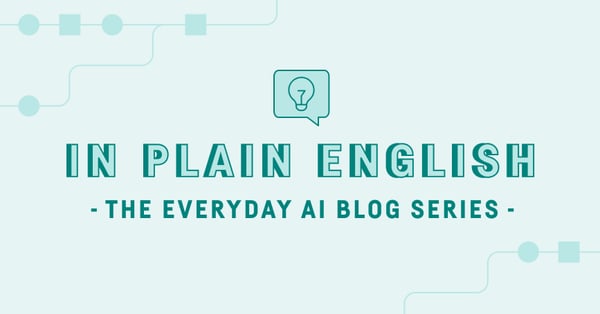In the ever-evolving realm of AI, a groundbreaking technique known as Retrieval Augmented Generation (RAG) is making waves. But what exactly is RAG and why should enterprises be excited about its potential? In the latest installment of our “In Plain English” blog series, we’ll cover the basics of RAG and how it works, as well as provide insights on why it’s a game changer.

Understand the Basics: How Does RAG Work?
At its core, RAG combines three essential elements in AI: retrieval, augmentation, and generation. Imagine your brain as a super-smart librarian.
When faced with a question, this librarian doesn't just generate an answer out of thin air. Instead, it sifts through a vast library of information, retrieving the most relevant bits to supplement its body of existing knowledge, and then crafts a new, tailored response. Similarly, the RAG process involves three steps:
- Retrieval: Extract pertinent details from a knowledge repository in response to a given query.
- Augmentation: Enhance the input query or prompt by integrating specific information gathered from the retrieved sources. This enriches the model’s comprehension by incorporating additional context.
- Generation: Produce a more knowledgeable and contextually nuanced response by leveraging the generative capabilities of the model on the augmented input.
Said another way, when you query a Retrieval-Augmented Large Language Model (LLM), the most relevant elements of your corpus (e.g., articles, documents, or web pages) are automatically selected and added to the query that is sent to the LLM. The additional information given augments the foundational knowledge the model already has, and the model then synthesizes the combined information to create a new, contextually rich response to your query.
Why Is Rag a Game Changer?
1. Enhanced Problem Solving:
To give some practical examples, it’s likely that knowledge workers like your customer service reps, technical support agents, or legal analysts often need to look up facts from policy manuals, case law, and other such reference material to answer questions. In some cases, the answers may be sourced from internal documents or require a citation of where the answer came from for compliance purposes. RAG is one method that enables this type of application.
RAG doesn't just provide answers; it can also guide users through the thinking process by returning the specific sources of information from your knowledge base that influenced its response. It's like having a virtual tutor that not only answers your questions but also helps you understand which reference materials it used to arrive at those answers.
2. Risk Mitigation:
Related to the notion of ensuring responses are credibly sourced, RAG also comes in handy when you want to ensure the LLM uses only approved source material to reduce the risk of hallucinations (which is when an LLM creates an output that is plausible sounding, but fabricated and not backed by data).
This is a significant caveat when accurate and credible information isn’t just a nice-to-have, but a must-have. In a data-driven role, you often need specific, timely insights you can completely trust — not just plausible responses.
Further, hallucinations are risky because they may (unintentionally) provide content that is incomplete or incorrect, which can lead to the spread of misinformation and contribute to the amplification of inaccurate or baseless claims. Users may lose trust in the reliability of LLMs if they consistently produce hallucinated or inaccurate information, which can undermine the utility of these models in various applications.
In legal proceedings, for example, precision and accuracy are paramount. In this context, the knowledge worker needs to ensure that the answers provided are absolutely accurate and grounded in fact due to the high stakes and potential legal consequences involved. Or, if an insurance agent provides a generalized answer to an individual about coverage or claims that doesn't apply to this specific person's policy, both you and the company may now be at financial risk.
RAG also enables citable sources for responses and could be useful when you want to “teach” the LLM information that it’s never seen during its training (whether that’s because the information is proprietary, domain-specific knowledge, or more recent than the training).
3. Efficiency and Accuracy:
Enterprises deal with massive amounts of data daily. RAG acts as an intelligent filter, rapidly extracting and presenting relevant information. This not only saves time but also ensures that decision-makers aren't drowning in unnecessary details.
RAG's ability to sift through vast amounts of information ensures that responses are not only accurate but also efficient. No more wading through heaps of data; RAG streamlines the process, delivering relevant content promptly. Plus, the body of knowledge you would have to feed an LLM as context is too big/expensive to send every time, so RAG’s selective-context approach makes more sense here.
4. Scalability and Consistency:
RAG can operate 24/7, ensuring consistent and scalable access to information. This is particularly valuable for global enterprises with teams spread across different time zones, ensuring that information is available whenever and wherever it's needed.
For many organizations, tribal knowledge lives in the memories of individuals and often getting the right answer is dependent on who you know (and takes time). By turning this tribal knowledge into corporate knowledge in the form of shared knowledge bases that the LLM can instantly access around the clock, you preserve this knowledge for widespread usage at enterprise scale.
Putting It All Together
As AI continues to advance, technologies like RAG are reshaping how we interact with information. The combination of retrieval, model augmentation, and generation is not just a technological leap. It's a step towards more intuitive and context-aware AI that can enhance the way organizations manage information, make decisions, and interact with both internal and external stakeholders.




